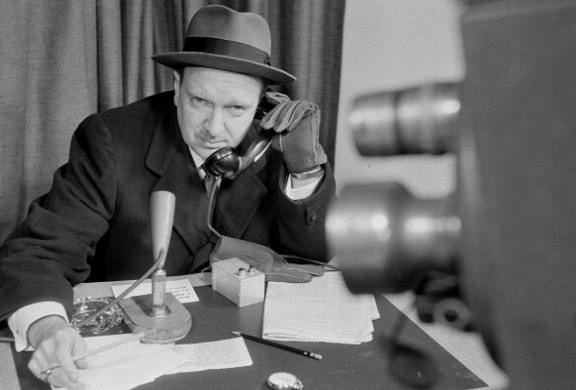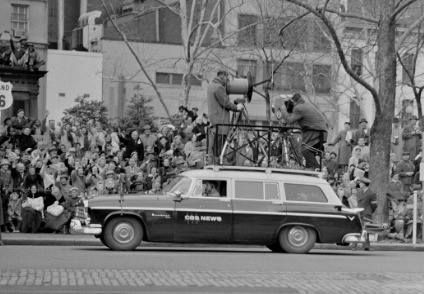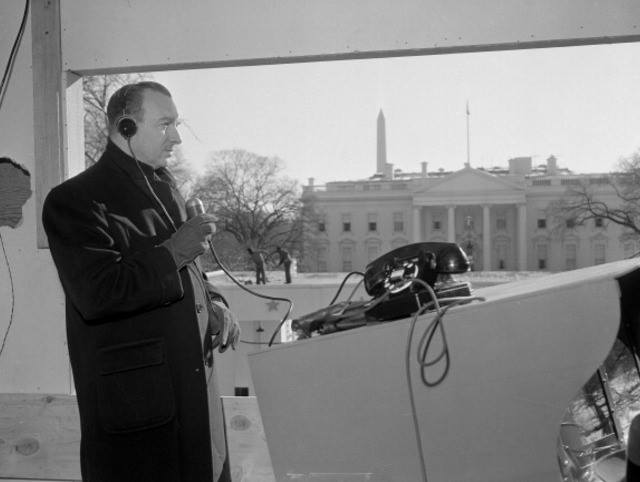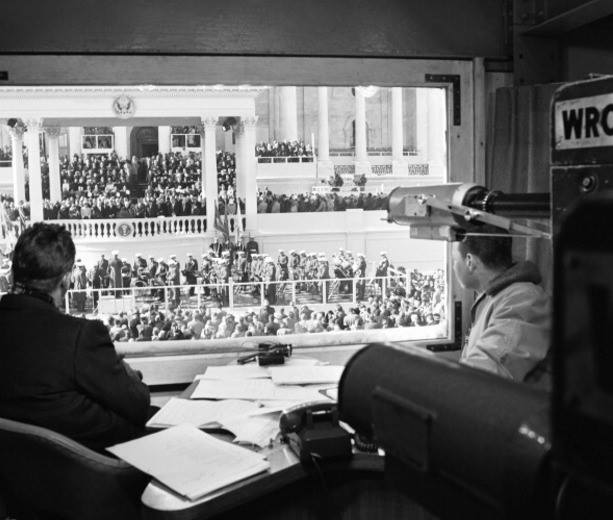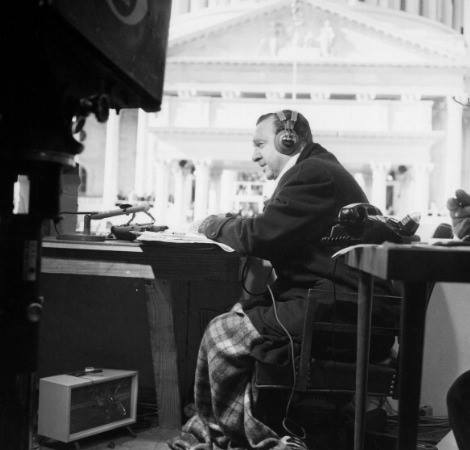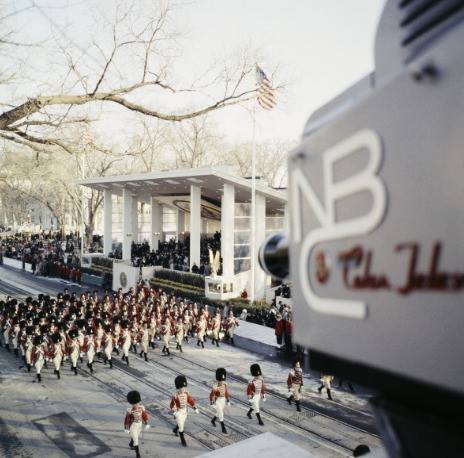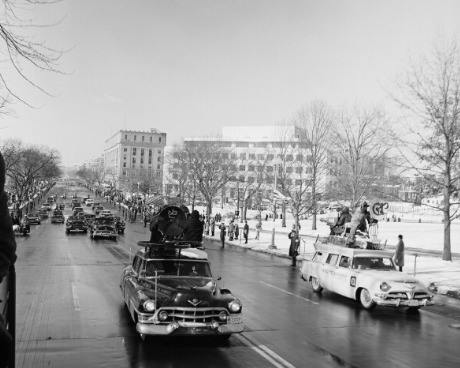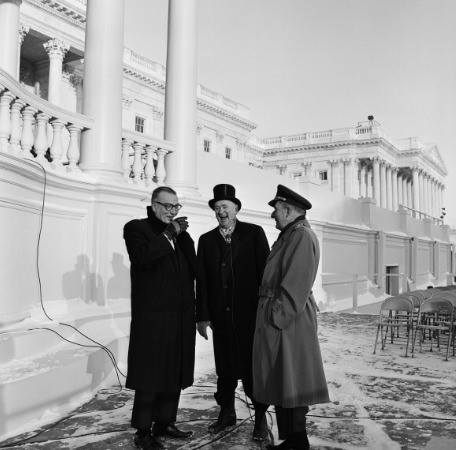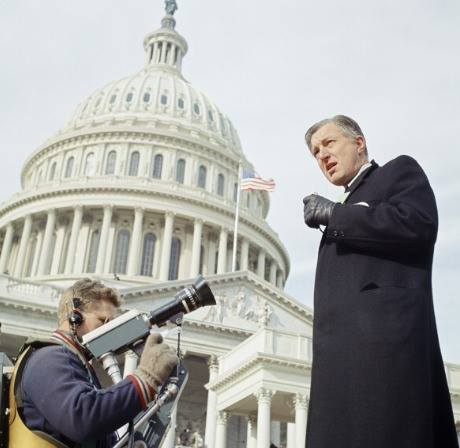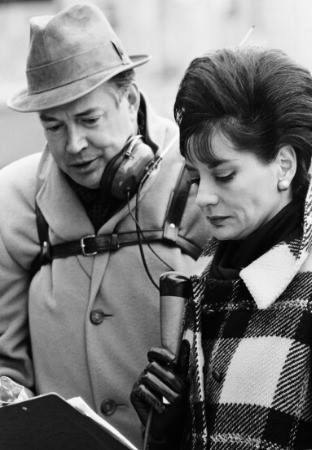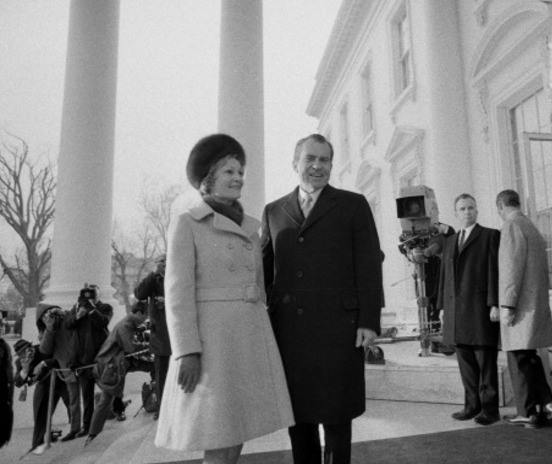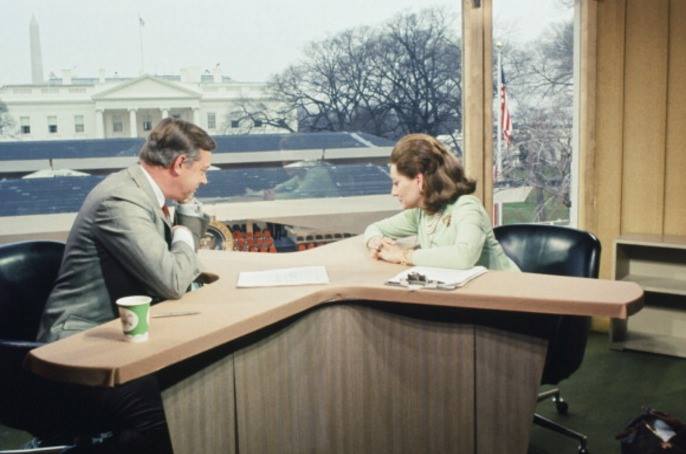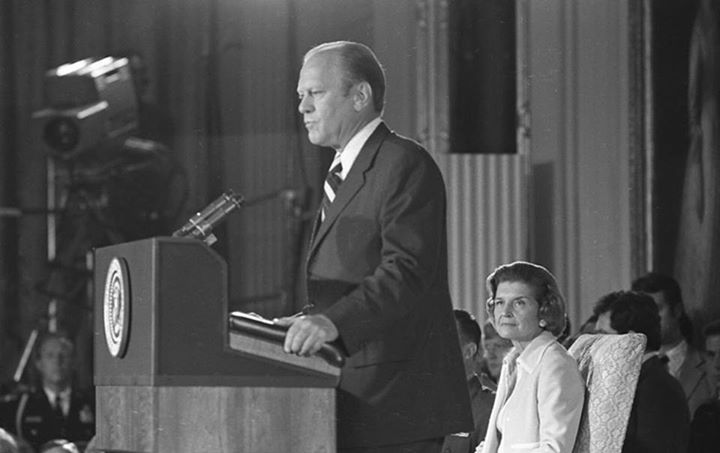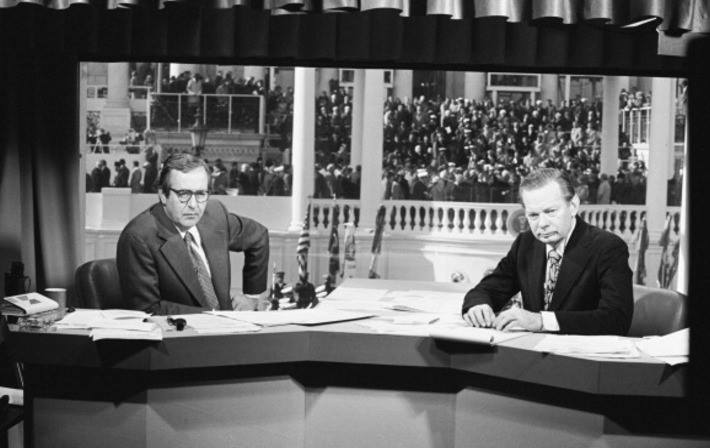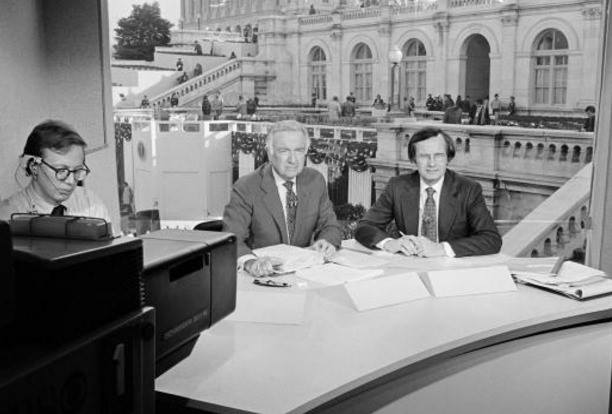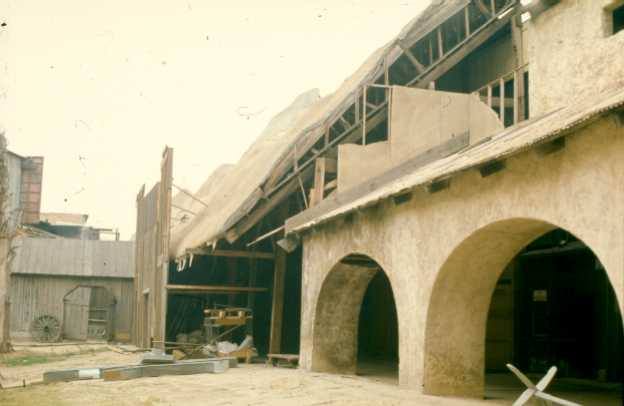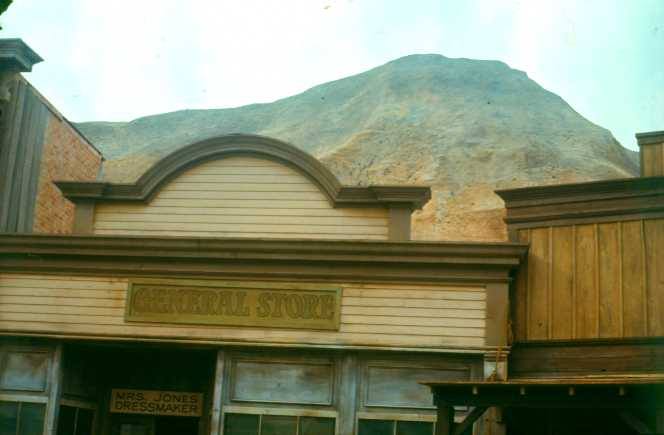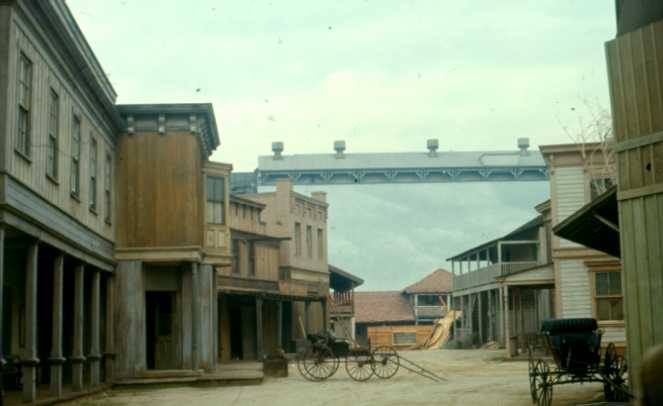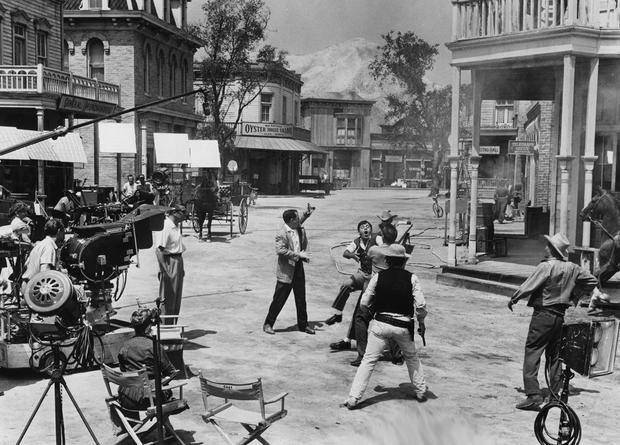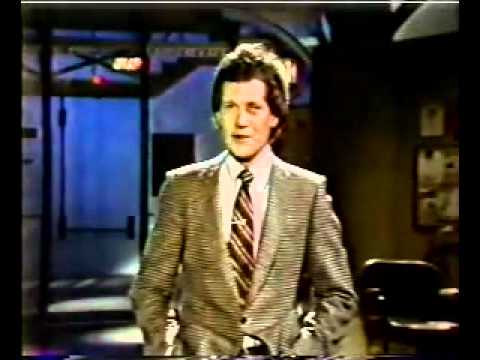
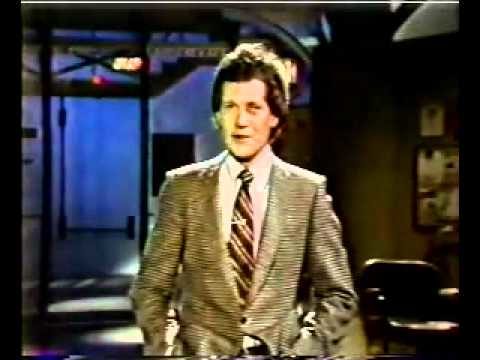
February 1, 1982…”Late Night With David Letterman” Debuts
February 1, 1982…”Late Night With David Letterman” Debuts
On this date in 1982, Dave’s show replaced Tom Snyder’s ‘Tomorrow’ show, and at the end of the first week, the ratings were 30% better than Snyder’s.
These three clips are from the debut night and show us the start, a tour of Studio 6A which ends in the control room with Director Hal Gurney leading the singers (you’ll see) and Dave’s first guest Bill Murray.
There are too many thing to list that made the show a hit and “different”, but here’s an example from that first week that had everyone talking. On the third night, baseball great Hank Arron was on and after his time with Dave, a camera followed him backstage where Marv Albert did a “post interview, interview” to see how it had gone, just like a post game interview.
We love you and miss you Dave, and thank you for all the laughs along the way! Enjoy your retirement…you’ve earned a rest. -Bobby Ellerbee
Show Open
Studio 6A Tour
First Guest, Bull Murry


ABC, CBS, NBC Anniversary Shows…Saturday Through Tuesday!
ABC, CBS, NBC Anniversary Shows…Saturday Through Tuesday!
Over the next four days, we’ll have the commercial free anniversary shows from the Big 3! Tomorrow, we start with the oldest network, NBC. On Sunday, it’s CBS and on Monday, ABC. Then on Tuesday, we’ve got Television City’s 50th anniversary show for you. Be ready for some great history and many major memories! -Bobby Ellerbee
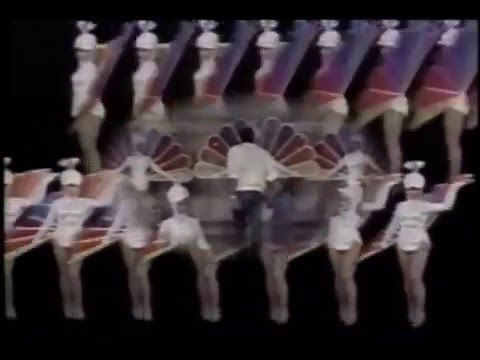
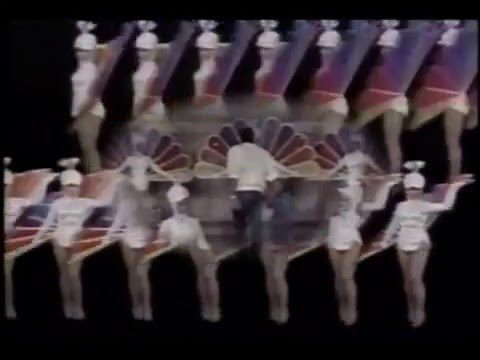
NBC 60th Anniversay Show…Mega Memory Tour #1
NBC 60th Anniversay Show…Mega Memory Tour #1
From now through Tuesday, we’ll have the NBC, CBS and ABC network anniversary shows for you here, plus a couple of surprises, but now, it’s time for tour #1.
This is 2 1/2 hours of NBC’s glorious history without commercials…well, almost. Ed Herlihy is here to tell you about the Kraft commercials he did, and we’ll see him in this NBC Tour themed production that has kind of a clunky intro, but all through this, there are a lot of looks at 30 Rock and Burbank, where it was all shot.
NBC has presented more recent anniversary specials, but none of those are available in their entirety like this one. As part of the tour, Milton Berle stands outside Studio 6B and confirms that the first TV show from that studio was his “Texaco Star Theater”.
Hope, Paar, Carson, Jolsen, Vallie, Chancelor, Allen, Huntley, Brinkley, Pauley, Cantor, Martin, Lewis, Abbott, Costello, Landon…westerns, dramas, soaps, sitcoms, news, radio, milestones, sports…it’s all here! Enjoy and share! -Bobby Ellerbee
https://www.youtube.com/watch?v=PiQT81Pe0uY
On May 12, 1986, more than 100 stars celebrated the National Broadcasting Company’s 60 years on the air in this special that features the debut of the new (a…

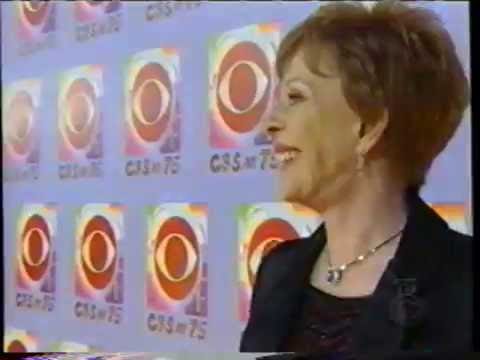
CBS 75th Anniversay Show…Mega Memory Tour #2
CBS 75th Anniversay Show…Mega Memory Tour #2
From now through Tuesday, we’ll continue NBC, CBS and ABC network anniversary shows for you here, plus a couple of surprises, but now, it’s time for tour #2.
This is 2 hours of CBS’s glorious history as it was presented in 2003, and like NBC, CBS has presented more recent anniversary specials, but none of those are available in their entirety like this one.
Gleason, Benny, Burnett, Cronkite, Griffith, Sullivan, Newhart, MTM, Barker, Skelton, Letterman and all the great shows from westerns, dramas, soaps, sitcoms, news, radio, milestones, sports are all here! Enjoy and share! -Bobby Ellerbee
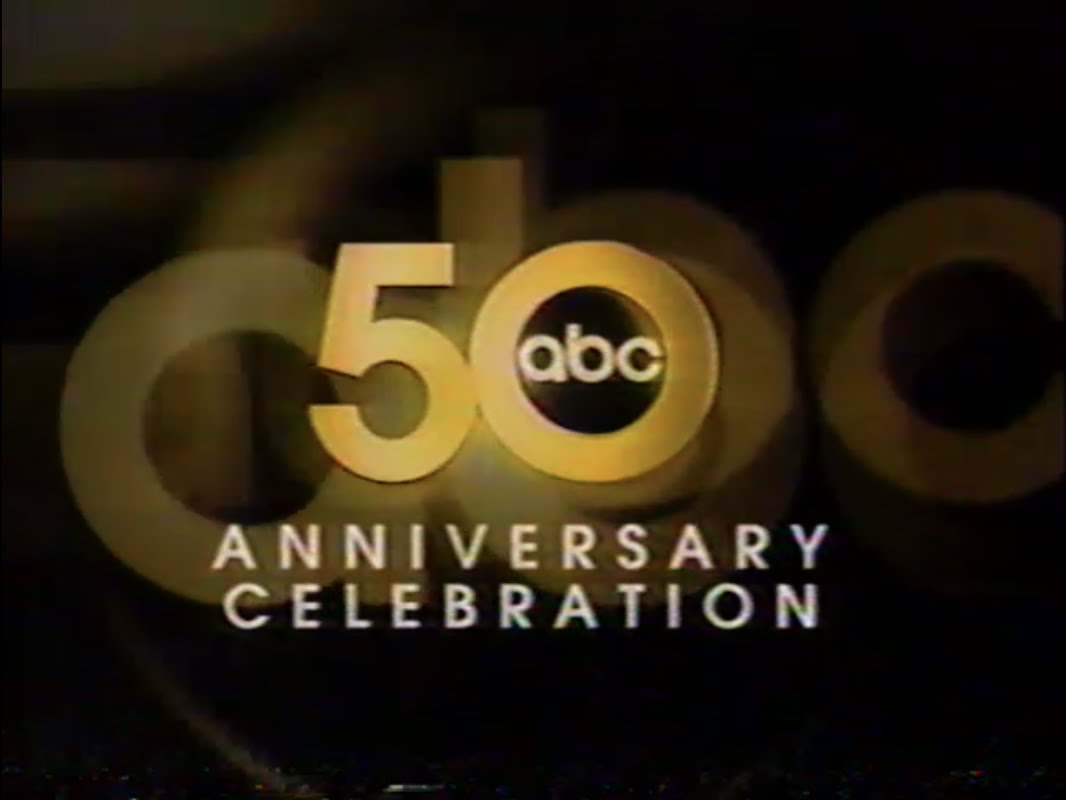

ABC 50th Anniversay Show…Mega Memory Tour #3
ABC 50th Anniversay Show…Mega Memory Tour #3
Today and tomorrow, we’ll continue NBC, CBS and ABC network anniversary shows for you here, plus a couple of surprises, but now, it’s time for tour #3.
This is 3 hours of ABC’s glorious history as it was presented in 2003, and like NBC and CBS, ABC has presented more recent anniversary specials, but none of those are available in their entirety like this one.
Dick Clark, Barbra Walters, Hugh Downs, John Trivolta, The Beaver, The Fonz, Cosel, Luke and Laura, and all the great shows from westerns, dramas, soaps, sitcoms, news, milestones, sports are all here! Even a nice TK41 as a backdrop. Enjoy and share! -Bobby Ellerbee
https://www.youtube.com/watch?v=I5OSbgbmo6Y
Includes commercials and a WFTV news open (seen on sister channel OTownNews). All copyrights are acknowledged. NO COPYRIGHT INFRINGEMENT INTENDED! SOLELY FOR…

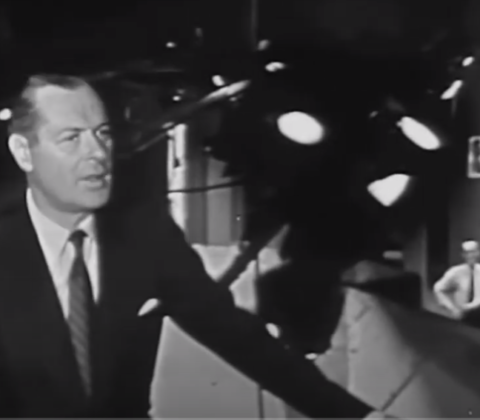
January 30, 1950…NBC Studio 8H Debuts As A Television Studio
January 30, 1950…NBC Studio 8H Debuts As A Television Studio
Actually, “The Voice Of Firestone” radio show had been simulcast from Studio 8H on September 5, 1949, and before that, at least two simulcasts of Arturo Toscanini conducting the NBC Symphony Orchestra were done from 8H as early as 1943. All of those broadcasts had all been handled as remotes though, as there were no television facilities in the studio then.
Around the end of August of ’49, 8H was closed and totally redone at a cost of over a million dollars.
The first show that we know of that came from the new television studio was NBC’s new one hour anthology series, “Robert Montgomery Presents”, with the debut episode “The Letter” being broadcast at 8 PM January 30, 1950, for a double debut of sorts.
Seen above it Robert Montgomery opening the show in it’s usual way, perched above the studio floor where the live production is about to take place in 8H.
When NBC began broadcasting from it’s new 30 Rockefeller Plaza location on November 11, 1933, the first radio show came from 8H, or as it was called then, The Auditorium Studio. It was the largest of the 27 studios in the building with 8G, also known as The Radio Guild Studio, second in size.
HAPPY BIRTHDAY 8H! -Bobby Ellerbee

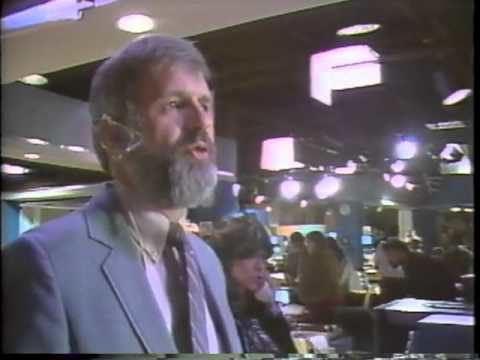
Inside Breaking News…Live At CNN For The Challenger Disaster
Inside Breaking News…Live At CNN For The Challenger Disaster
On January 28, 1986, about a half hour before the Challenger space shuttle was launched, a CNN tape crew had come into the main news studio to shoot a feature on how the news is covered. What their camera recorded in Atlanta was the same kind of chaos erupting across the country in other news rooms. Where were you when you heard the news? -Bobby Ellerbee
A crew just happened to be in the CNN Newsroom/ Studio shooting promotional/documentary footage of a random day’s work at the network. This is their montage …
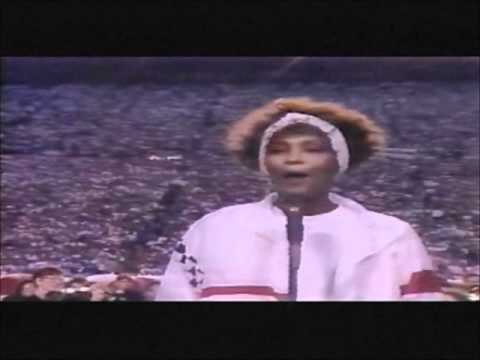
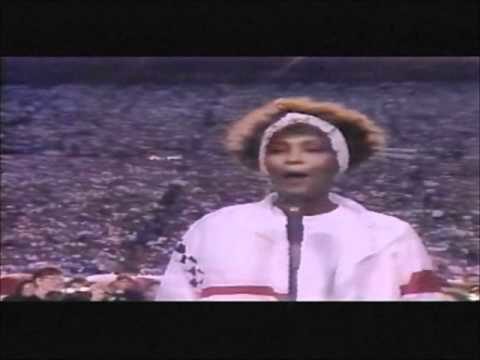
January 27, 1991…Whitney Houston Mesmerizes America
January 27, 1991…Whitney Houston Mesmerizes America
The Story Of The Best Ever Version Of “The Star Spangled Banner”
Here is our national anthem sung like never before, and the backstory of how it came to be. Please watch it with the volume high and don’t be surprised if you tear up to, what most consider, the most moving rendition ever.
Few know that the entire performance was prerecorded…music and voice. In order to keep the performance from sounding thin, as most stadium performances tend to be, Houston wanted the great arrangement, to be as powerful and moving as it was when she first heard it ten days earlier.
This performance was the opening of Super Bowl XXV at Tampa Stadium, January 27, 1991…10 days into the Persian Gulf War. Whitney was backed by the Florida Orchestra along with music director Jahja Ling, before 73,813 fans, 115 million viewers in the United States and a worldwide television audience of 750 million.
When asked to perform, Houston knew instantly how she wanted to interpret the tune. Rickey Minor, her longtime musical director, and later Jay Leno’s band leader, said that in a crowd that large and loud, it would be impossible for Houston to hear herself, so in order to have the most powerful performance, the decision was made to prerecord both the music and vocals.
Although there was no audio from her mic, there is no question that she sang this with all her heart live, but it was her pre-recorded voice that the audience heard. She did it in one take in the studio!
The NFL had no qualms about the song being prerecorded, even if Houston would be criticized for it. The NFL’s issue was with the meter. “The Star-Spangled Banner” is written in 3/4 time — not quite brisk, but waltzy. Houston and vocal arranger Minor, as well as bassist-arranger John L. Clayton, changed it to 4/4, slowing it down.
“All was in place for what many of us thought would be one of the greatest versions of the national anthem ever performed,” said Jim Steeg, who for 25 years had been in charge of the Super Bowl for the NFL.
“Then on Jan. 17,” as Steeg further recalled it, “senior executives with the NFL asked to hear the recording. A tape was overnighted to Buffalo, where the AFC championship game was played. The next day I was told the version was viewed as too slow and difficult to sing along with. Could I ask to have it redone.” Perhaps the NFL was afraid there would be discontent in the stands, as there had been when Jose Feliciano dared to stray in the anthem before Game 5 of the 1968 World Series. So Steeg called John Houston, Whitney’s father and her manager at the time. “The conversation was brief,” Steeg said. “There would be no rerecording.”
Houston’s performance electrified the stadium and soon after, popular demand prompted Houston’s record label to release a single of her national anthem performance that hit the top 20 on the Billboard charts.
“I think it might well be the best Super Bowl performance of all time, ” said Billboard Magazine editor Danyel Smith. I AGREE! God Bless America! -Bobby Ellerbee
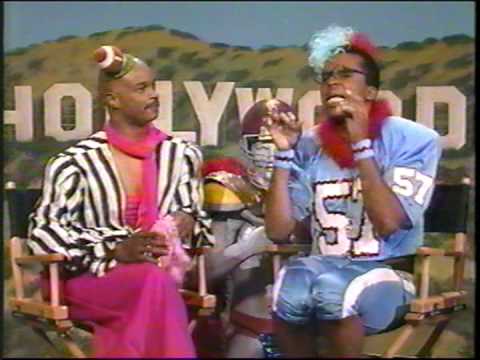

January 26, 1992…First Successful Super Bowl Counter Programming
January 26, 1992…First Successful Super Bowl Counter Programming
CLASSIC! Men On Football…’In Living Color’
This is one of my all-time favorite comedy pieces from “In Living Color”! This whole thing is funny, but it heads for the outer limits at about the 4:30 mark, so do not drink anything after that unless you want to blow it out of your nose!
This was a special live episode (usually it was prerecorded) that aired on Fox, Sunday, January 26, 1992 and was broadcast opposite the Super Bowl XXVI halftime on CBS. It drew about 25 million of those viewers. After the half hour live special, most returned to CBS which had an audience estimated at 79.6 million viewers.
This was the first time that a major television network successfully scheduled Super Bowl counter-programming. The ‘In Living Color’ Super Bowl halftime special was branded by the network as ‘The Doritos Zaptime-In Living Color Super Halftime Party’.
During the “Men on Football” sketch, Damon Wayans and David Alan Grier adlibbed a suggestion that Richard Gere and track and field star Carl Lewis were gay. Lawsuits were filed and the tape was edited for reruns and syndication. This is the original unedited version! Enjoy and share! -Bobby Ellerbee
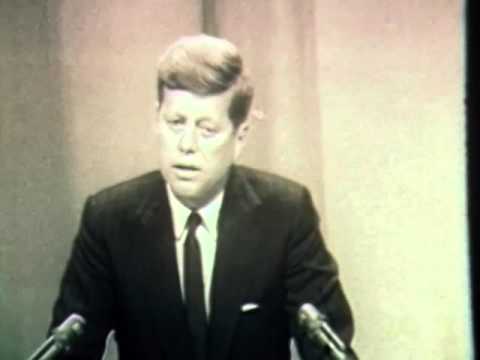

January 25, 1961…Television’s First Live Presidential News Conference
January 25, 1961…Television’s First Live Presidential News Conference
There are three videos with this article; the embedded footage is of President Kennedy hosting the first live news conference, and notice at 10:05, a reporter asks if taking questions live is a good thing given that live there is the occasion to mis-speak and rile international tensions (hint, hint), and the second video shows Kennedy’s amazing grace and humor. The third is part of Eisenhower’s first televised news conference that was shot on film.
On this day in 1961, President Kennedy held the first ever live presidential news conference. It originated from the auditorium of the State Department and was carried live on both radio and television.
In the period preceding the Kennedy presidency, the rules governing press conferences favored the president. The sessions were off-the- record events, from Woodrow Wilson through Harry Truman. If the president said something he believed unwise, he could alter the quote.
President Truman, for example, was able to back away from a comment about Senator McCarthy that he made in a March 30, 1950, press conference. Truman said: “I think the greatest asset that the Kremlin has is Senator McCarthy.” When one of the reporters commented that the president’s observation would “hit page one tomorrow,” Truman realized he had better soften the statement. He “worked” with reporters and allowed the following as a direct quotation: “The greatest asset that the Kremlin has is the partisan attempt in the Senate to sabotage the bipartisan foreign policy of the United States.”
When the rules governing press conferences were off the record, chief executives held them once or twice a week. In fact, Calvin Coolidge, who held the most press conferences for the number of years he was in office, had 521 sessions or an average of 93 a year. But once they went on the record in the Eisenhower administration, the numbers dropped drastically. Now they had to take time preparing for the sessions and then be careful what they said when answering questions. Eisenhower and Kennedy respectively had 24 and 23 press conferences a year.
The first televised (film footage) press conference was held January 19, 1955. President Eisenhower came into the Indian Treaty Room, a room with poor acoustics and limited seating and announced the “experiment” they were about to be part of. https://www.c-span.org/video/?c4480322/president-eisenhowers-first-televised-press-conference
In fact, television made an enormous difference in the significance of press conferences in presidential publicity. It has been a “disturbing influence”—presidents have made mistakes though only rarely—but the sessions also have been an enormous resource for presidents as they seek to explain policy and themselves to the public.
President Kennedy was able to assimilate the new technology into an invigorated presidency, much as he had during the campaign and in the presidential debates. Kennedy’s press conferences were in many ways a symbol of his successful use of television to promote his active agenda.
http://www.youtube.com/watch?v=mXDLLUOxmsY At this link is a video that reminds us of JFK’s easy style in these press conferences. He was the first American president to really understand television and how to use it to his advantage, which started during the campaign.
The image of a fast-paced presidency was not an illusion in the Kennedy years. It was real. Take the pace of their public speeches. President Eisenhower and President Kennedy had a few more than 700 speeches and remarks, big and small, during their presidencies. For President Eisenhower those public remarks covered eight years and for Kennedy, it was less than three years. Many of those speeches got to the public either through their being televised or through news broadcasts.
Because of the high demand by reporters for seats, the conferences had to be moved from the White House compound where they were held first in the president’s office – Wilson through to Truman – and then moved to the larger Indian Treaty Room in the Truman and Eisenhower administrations. Even that room turned out to be a cramped space. Kennedy moved them here in the State Department auditorium where there was more space for the 200+ reporters covering him and his press conferences.
Reporters were more willing to challenge the new president than was true in the Eisenhower years when the goodwill from World War II was still in the air. At the end of the Eisenhower administration, reporters lost their willingness to take at face value the government’s accounting of events.
The U2 spy plane incident changed the relationship for many reporters with their government. It was an incident where the US government was caught in a lie – it was a spy plane the Soviets shot down, not the weather plane the White House said it was. When reporters found out they were lied to, they became wary of the accounts they received from White House officials.
The incoming team of reporters, many of whom followed Senator Kennedy as he campaigned for the presidency, caught the public eye as did the new president. They all prospered from press conferences where each side sought to establish control in its relationship with the other. And so it goes. -Bobby Ellerbee
https://www.youtube.com/watch?v=lFde6u-OPj8
President Kennedy begins the press conference with a statement concerning the scheduling of the Geneva negotiations for a nuclear test ban. He then announces…

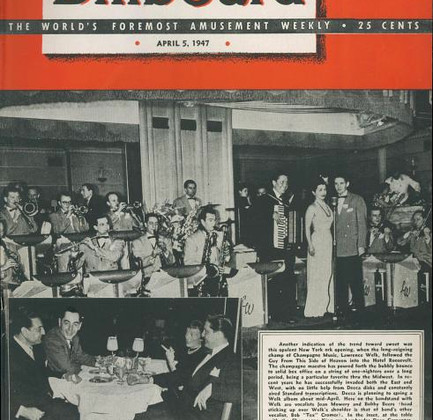
70 Years Of Billboard Magazine…Massive Memory Lane Archive
70 Years Of Billboard Magazine…Massive Memory Lane Archive
At this link, are full copies of every weekly Billboard Magazine from 1940 through 2010. Although from the mid ’60s on, Billboard’s main focus was records, radio and music, the late ’40s through the late ’50s issues have a good bit of television news at the start of each issue.
https://books.google.com/books/about/Billboard.html?id=KwsEAAAAMBAJ
On the page, use the sliding bar under the covers to pick a date, like your birthday to see what was happening then and click on the image. Just under the cover image that pops up, there is a “Preview this magazine” option in blue..click that to see the whole issue. Enjoy and Share! -Bobby Ellerbee
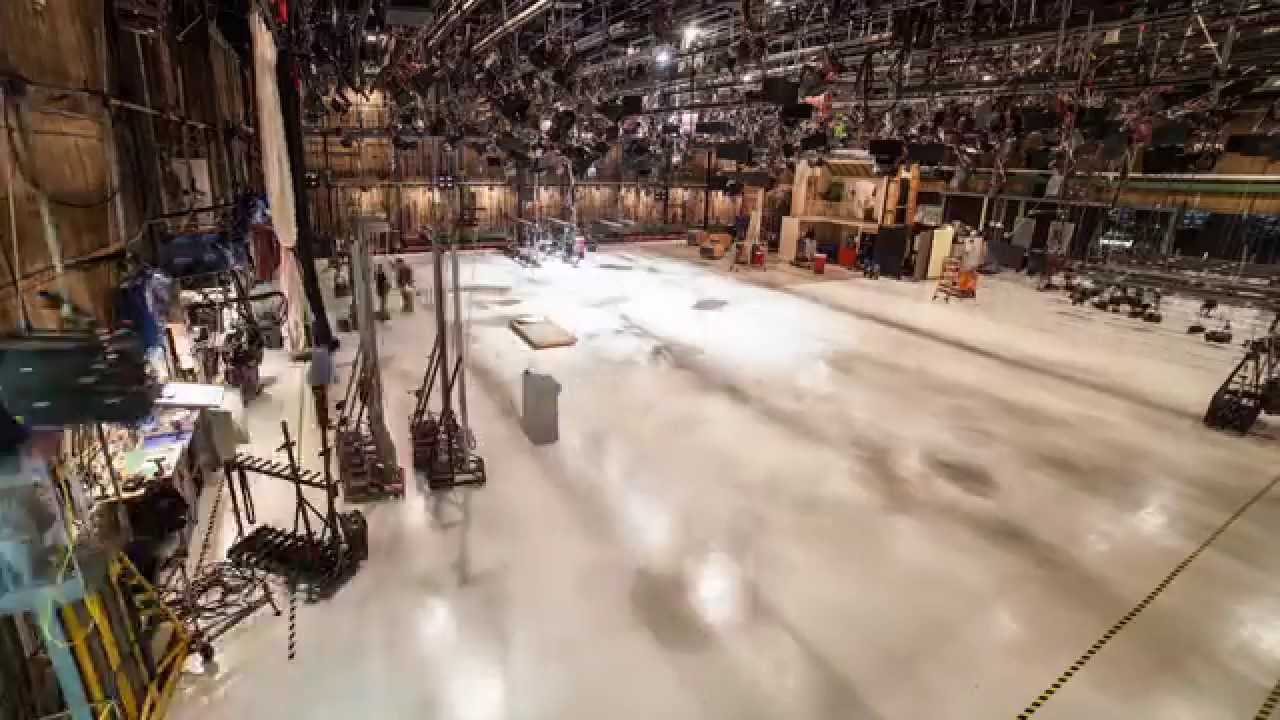
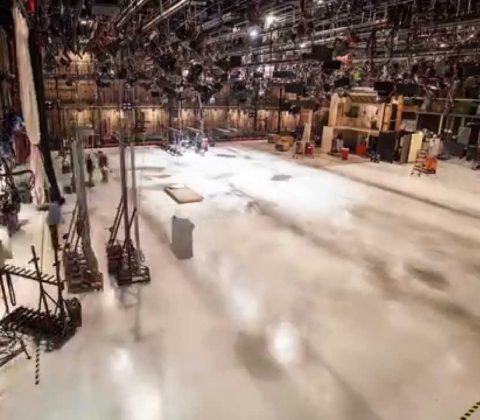
January 23, 1975, 1977 & 2015…Debuts And Milestones
January 23, 1975, 1977 & 2015…Debuts And Milestones
“The Bold And The Beautiful”, “Roots” And “Barney Miller”
On January 23, 2015 CBS celebrated the 7000th episode of
“The Bold And The Beautiful” with a special milestone episode that broke format and featured a retrospective that showcased the most iconic moments and the history of the show’s creation.
In addition, CBS Television City dedicated Studio 31 to the show’s executive producer and head writer Bradley P. Bell. Here is a time lapse video of Studio 31 being dressed for the show.
https://www.youtube.com/watch?v=3kIJYrkmgF0
40 years ago today, “Roots” began airing on ABC for eight consecutive nights from January 23 to January 30, 1977. Over half of the country tuned in to watch and soon after, a wave of awards washed in. In this video from “The Wendy Williams Show” the stars talk about some interesting things that happened on the set.
http://www.youtube.com/watch?v=5EqO1680evM
Today in 1975, “Barney Miller” Debuted On ABC. The series was born out of an unsold television pilot, “The Life and Times of Captain Barney Miller”, that aired on August 22, 1974 as part of an ABC summer anthology series, “Just for Laughs”.
In the pilot, Linden and Vigoda were cast in their series roles, but no other other eventual cast members were present. That pilot was shot on film at CBS Studio Center, where the sets of the 12th Precinct and the Miller apartment were originally built.
When the regular series went into production in late 1974, the series went to videotape, and the sets were moved to the ABC Television Center in Hollywood, and later to ABC at Sunset Gower, where they remained until production ended on the series in 1982.
At this link, https://youtu.be/lnn1jQmAGzk?t=46s Hal Linden talks about how the show was shot. Enjoy and share! -Bobby Ellerbee
The Bold and the Beautiful time-lapse video of The Bradley P. Bell Stage 31 at CBS Television City, in honor of 7,000 episodes, is a behind-the-scenes look a…
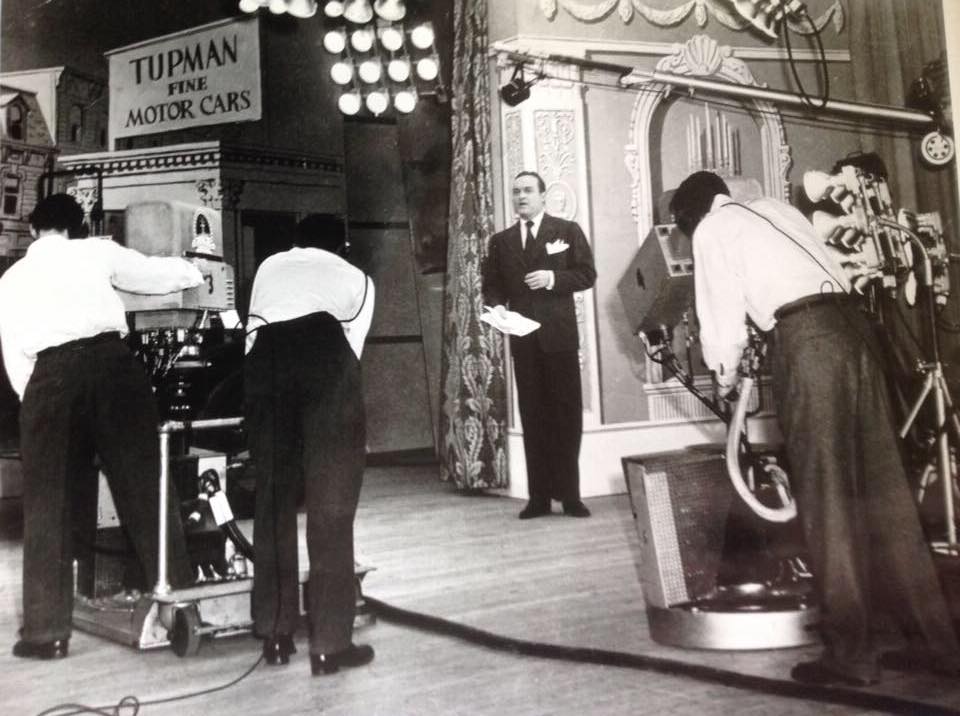

KTLA Anniversary Show
MUST SEE HISTORY OF EARLY LOS ANGELES TELEVISION!
KTLA’s 70th Anniversary Is Today! January 22, 1947 – 2017
This amazing video is packed with ultra rare historical footage of not only KTLA, but from the early days of all the Los Angeles television stations!
The show is hosted by Bob Hope, Betty White, Steve Allen, Dinah Shore, Dick Enberg and MANY more! This 40th Anniversary broadcast video even has a very good timeline below, but if you can, make the time to see it ALL!
This is one of the very best historical presentations you will ever see!
Below are minute to minute guides to help you take this all in…it is packed with history!
0:00 Program opening.
1:47 Clips from “The Jazz Singer.” History of the creation of television.
2:25 Early newsreel showing early television makeup.
2:50 Early television broadcasts of KTLA Channel 5.
4:30 Bob Hope talks about early television. Early television broadcasts. Great studio shots of that first day & Hope on camera.
8:06 1936 Olympic broadcasts. Klaus Lansberg, early television man. Station W6XYZ established. Early home shopping program.
10:04 Eddie Resnick, early cameraman talks about his work at the station. Pray Marco was a show similar to the lottery. Mike Stokey’s Pantomime Game Time, a show like pictionary. 1949 first Emmy Awards at Hollywood Athletic Club. Pantomime Quiz won best show.
12:09 Shirley Dinsdale with Judy Splinters (puppet) talks about winning first Emmy for most entertaining personality. Six awards were given at this first Emmy Awards show, and four went to KTLA. List of stations and when they began.
13:37 The Marshall of Gunsight Pass, early Western show. Clip from 1949. Al Jarvis, former radio disk jockey, had talk show with Betty White. Yer Ole Buddy, early comedy show. Clip from 1948. Bud Stefan talks about the show. Bill Welch did early sports shows. Talks about how many lights were needed in the studio due to the low sensitivity of the cameras.
18:07 Music and variety shows. Steve Allen talks about variety shows and venues in Santa Monica. He shot the shows that took place there.
25:10 Frosty Frolics, an ice skating show from Pasadena with host Stan Chambridge. Musical Adventure with Korla Pandit clip. Pandit talks about the show. Larry Finley talks about program he did called “Sell-a-thon.”
30:42 The Johnny Otis Show from 1960. Steve Allen talks about clip from 1962 from his show that involved a lot of pie throwing. Show called Melody Ranch with Gene Autry. Autry talks about how he changed the station after he bought it. Liberace show from 1951, Carson’s Cellar from 1952.
34:57 Early KTLA commercials.
36:03 Sponsor info.
36:17 Dinah Shore show from 1951 with Chevrolet ad. Shore talks about her early television days. Segment on “reality shows.” 1949 clip from City at Night. Ken Graue talks about the show, which was completely improvised and live. John Polich supervised the show; he talks about it.
39:05 Handy Hints with Dick Garten and Dorothy Gardiner. Hollywood Reel, which looked at stars. Clips of Barbara Bel Geddes and Ronald Reagan. Shore talks about early videotape programs, such as Emergency Ward and the Jack LaLanne show, an exercise show from 1958. LaLanne talks about the early resistance to his program. He claims to be the first to get athletes and women to work out with weights. Seven Keys, an early game show from 1960. Jack Narz talks about the show.
44:19 Adventures in Hypnotism, a live program where people get hypnotized. Emile Franchel was the host/hypnotist. Ralph Story’s Los Angeles from 1965, a public service program. Hal Style’s Help Thy Neighbor. The Baxters, hosted by Steve Edwards, clip from 1979.
47:30 Scared Straight, a documentary hosted by Peter Falk where juvenile delinquents are confronted by prisoners, from 1978.
48:30 Stan Freeberg talks about children’s programs. Time for Beany, puppet show from 1949. Daws Butler, one of the puppeteers, talks about the show. Sandy Dreams, first show with written script. Space Patrol from 1950. Tim McCoy show with Native American actor, Iron Eyes Cody. Playcrafters Club from 1954. Ding Dong School from 1960.
55:22 Cartoon Express with Engineer Bill. Bill Stula talks about the show. John Rovick talks about his role as Sheriff John. Shebang! With Casey Kasem. Clip of The Doors on the show.
1:03:55 Freeberg claims he got a letter saying that Time for Beanie was Albert Einstein’s favorite show.
1:04:40 Commercial for Calvin Klein’s Obsession for men cologne. Commercial for Toyota dealers of Southern California. Ad for Disneyland. Ad for Derma-Safe laundry detergent.
1:06:51 Hal Fishman news at ten story promo. Ad for Disneyland Circus Fantasy 87 and Carl’s Jr. Ad for Columbia Savings. Ad for British Airways. Ad for Renault Medallion.
1:09:10 Section on sports with Dick Enberg at the Olympic Auditorium. Destruction Derby, Roller Derby, Moto Polo clips. Bowling for Dollars show clip from 1970. Wrestling clips from 1950. Sports Stars on TV. The Tablehopper clip from 1959. Miss Universe Pageant clip from 1956.
1:18:30 American Express ad. Ad for Ralph’s supermarket. Ad for Pan Am airlines. Ad for Dreyer’s Grand Ice Cream. Ad for Campbell’s soups. Ad for Southern California Hyundai Dealers. Ad for Jack in the Box restaurants.
1:22:22 Hal Fishman at atomic test site in Nevada talks about news coverage. Footage of TV coverage of the test. Klaus Landsberg set up the coverage. Clip from War of the Collosal Beast. Stan Chambers, news reporter for over 40 years. Cleve Lansberg talks about watching his father direct television shows. Various newscasters relate anecdotes.
1:36:48 George Putnam talked about the early days at KTLA. Other newscasters talk about the early days of television.
1:38:53 Section on weathermen. Jim Hawthorne talks about the first weather broadcasts. Dr. George Fishbeck talks about his forecasts. Pat Sajak talks about being a substitute weatherman, which eventually led to his being asked to host the Wheel of Fortune show.
1:41:52 Ad for Oppenheimer Mutual Funds. Ad for Renault Medallion. Ad for Blue Cross of California. Geraldo Rivera does ad for show called Innocence Lost. Sponsor info. Ad for American Express. Ad for Ralph’s supermarket.
1:46:24 Clip from “The Jazz Singer.” Information about KTLA’s current situation. They were just purchased by the Tribune Corporation. There is a list of events that they plan to cover and a promo for the night time news. Shots of old studios and what they are being used for now. Montage of shots from early programs with Simon and Garfunkel song.
1:51:33 Tape ends abruptly.
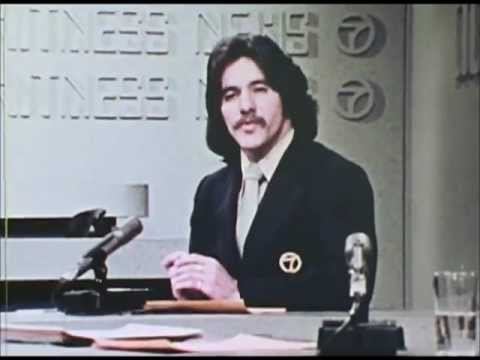
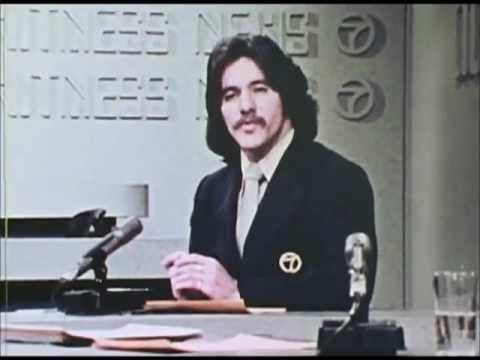
A Day In The WABC TV News Room…1973
A Day In The WABC TV News Room…1973
In an a year that has been so tumultuous for the television news business, when even fair and accurate reporting has come under attack, I thought this would be a good time to take a look back at how the process actually unfolds at a big local news department.
This great video is nearly a half hour long, and takes us through a full day of activity at the WABC news room, and studio. From assignment editors handing out local stories to crews and reporters, including Geraldo Rivera, to rushing film via motorcycle couriers back for editing, and finally to air with anchors Bill Beutel and Roger Grimsby.
According to the address above the door, this newsroom was at 77 West 66th Street, at the corner of Columbus Avenue, where the WABC news studio is now. The street numbers, and the ABC campus have changed a bit over the years and I think the live studio they were running to is in what is now 77 West 66th.
As you will see, the studio is a few buildings down, and was perhaps in 7 West 66th. Every piece of film and graphics, and talent had to make the mad dash down the street to the studio building.
You may have noticed the redundant use of the word “film”, but in ’73…that was still the main medium for news. At least it was color though, and took 40 minutes to develop.
The process of getting the script to teleprompters starts at around 18.5 minutes in and the broadcast shots come soon after.
Some nice shots of the editing process here, and the Norelco cameras have the extra tall dome tally lights…interestingly, only the very top of the tube light illuminates and you’ll hear the anchors discuss that at the very end, after the broadcast. Those tall tally lights were after-market-add-ons and were made to be taller than the teleprompters most mounted above the lens, but WABC is using and under lens setup.
Even for those of us not from New York, there are a lot of memories here like the Vietnam war protest Geraldo is covering, Burt Reynolds and Dianne Canon who are making “Shamus”, and for New Yorkers, a lot of drive by memories from the news cars.
Thanks to long time ABC cameraman Howie Ziedman for the video link. Enjoy and share! -Bobby Ellerbee
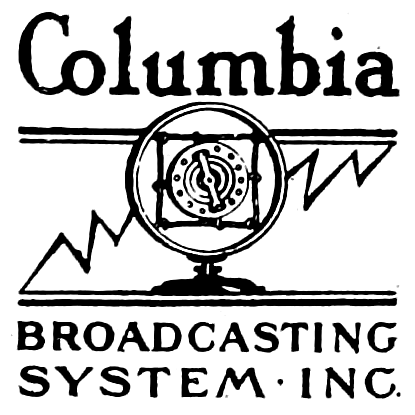

January 18, 1929…CBS Becomes A Broadcaster
January 18, 1929…CBS Becomes A Broadcaster
Until this day in 1929, the Columbia Broadcasting System was merely a program service providing radio entertainment features to a string of 16 stations connected by an AT&T line. With the purchase of the A.H. Grebe, Atlantic Broadcasting Company’s Manhattan based station, WABC…CBS itself was on the air. (November 2, 1946, WABC call letters changed to WCBS).
There is an interesting story on why this happened, which involves WOR, but first, here is my brief history of The Columbia Broadcasting System.
In early 1927 Arthur Judson, the impresario of the Philadelphia and New York Philharmonic orchestras, approached the National Broadcasting Company (NBC), which at the time was America’s only radio network, with an idea to promote classical music by airing orchestra performances. NBC declined.
Undaunted, Judson founded his own broadcasting company, which he named United Independent Broadcasters, Inc. (UIB).
Lacking a strong capital base, UIB struggled to stay afloat. However, in the summer of 1927, Judson found a rich partner in the owner of Columbia Phonograph Company, Louis B. Sterling. Columbia Phonograph bought UIB’s operating rights for $163,000. The new company was named the Columbia Phonograph Broadcasting System.
Columbia Phonographic took over on September 18, 1927, with a presentation by the Howard Barlow Orchestra with network affiliate WOR in Newark, New Jersey, feeding fifteen other UIB network stations. Operational costs were steep, particularly the payments to AT&T for use of its land lines, and by the end of 1927, Columbia Phonograph wanted out.
In early 1928, Judson sold the network to brothers Isaac and Leon Levy, owners of the network’s Philadelphia affiliate WCAU, and their partner Jerome Louchenheim. Soon after, the Levy brothers had involved their soon to be relative, 26 year old William S. Paley, who’s sister was engaged to Leon Levy. Paley was the son of a well-to-do Philadelphia cigar maker.
With the record company out of the picture, Paley quickly streamlined the corporate name to Columbia Broadcasting System. Paley had come to believe in the power of radio advertising since his family’s La Palina cigars had doubled their sales after young William convinced his elders to advertise on radio the year before.
Although the network was growing, it did not own a radio station of its own…yet. In December of 1928, CBS bought A.H. Grebe’s Atlantic Broadcasting Company in New York City with the call letters WABC (no relation to the current WABC), which would become the network’s flagship station.
Now, here’s the story behind why CBS bought WABC.
It was Grebe’s hope to expand the Atlantic Broadcasting Company into a network operation, now that NBC has shown the way. But in September 1928, an opportunity arose that would make this station one of the major players in radio history.
The Columbia chain did not own an outlet in New York. Its local affiliate was WOR, which became convinced they could produce local programs of equal quality to the CBS shows.
When WOR refused to clear additional time for the CBS network, WABC stepped in to become the second NYC affiliate, a move it hoped would justify a power increase. For a few weeks in late 1928, WABC was the CBS station on Sunday, Tuesday, and Thursday, with WOR carrying the network on the other four days, but soon WOR dropped CBS completely.
In November 1928, Columbia offered to buy either of its New York area affiliates, and President William S. Paley negotiated with both Grebe and Bamberger. WOR’s facilities were superior, but Paley chose the less-expensive WABC, and in December the sale was completed.
The sale price was $390,000, though the appraised value of the studios and transmitter was just $130,000. Grebe had apparently let the WABC studios go to seed, for Paley reported a mess on the seventeenth floor of Steinway Hall. Among the assets were goods accepted as payment from sponsors; jewelry, kitchenware, and reportedly even some live chickens.
WABC came with a bonus though…it was located in the brand new Steinway Hall at 109 West 57th Street in Manhattan, across the street from the Carnegie Hall.
Concerts were broadcast from the Steinway concert halls downstairs, but upstairs, there were only 4 rooms. In need of studios and offices, the network moved in July 1929 into the bottom six floors of a new building at 485 Madison Avenue at 52nd Street, in the heart of the advertising community.
Initially, six studios were built on the 4th, 5th and 6th floors of the CBS space, and the bottom three floors were the CBS sales and programming offices. Eventually, CBS would take over the building and occupy if for the next 35 years.
Within a few years, CBS had nearly 50 stations in its network. Since the number of affiliates a network possesses determines the number of people it can reach, which in turn determines what a sponsor is charged, CBS was soon on firm financial ground. By 1930 CBS had 300 employees and total sales of $7.2 million. Enjoy and share! -Bobby Ellerbee


Television & The Presidential Inaugurations…Part 1
Television & The Presidential Inaugurations…Part 1
President Harry Truman’s January 20,1949 inauguration was the first to be televised to the 2,000,000 sets in use in the US, but television did not reach the west coast until Truman’s 1952 speech from San Francisco was telecast.
In the photo, the raised platform is for the radio reporters, newsreel cameras, and two pool TV cameras, with at least one more live camera in use on the ground, and perhaps more. I think this was the only televised part of the day, with no live TV coverage attempted on the parade portion.
At the link is a rare kinescope recording of Truman’s Inaugural Address. https://www.youtube.com/watch?v=gytbJo_bmxA
Here are some mass media firsts associated with covering the inaugurations over the centuries.
First ceremony to be reported by telegraph: James Polk, 1845.
First ceremony to be photographed: James Buchanan, 1857.
First motion picture of ceremony: William McKinley, 1897.
First electronically-amplified speech: Warren Harding, 1921.
First radio broadcast: Calvin Coolidge, 1925.
First recorded on talking newsreel: Herbert Hoover, 1929.
First television coverage: Harry Truman, 1949.
First live Internet broadcast: Bill Clinton, 1997.
Here is the first inauguration to ever be captured on motion picture film. It is that of Willam McKinley on March 4, 1897.
https://www.youtube.com/watch?v=pO_aOe_FM2Q
In 1937, Franklin Roosevelt took the oath of the Presidency for the second time, but for the first time on January 20th. The 20th Amendment changed the date from March 4 to January 20 when it was ratified in 1933.
More on soon! -Bobby Ellerbee

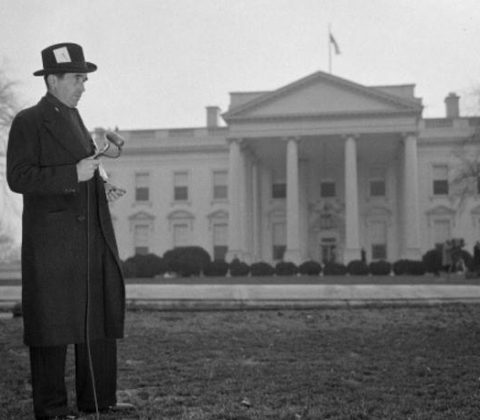
Television & The Presidential Inaugurations…Part 2
Television & The Presidential Inaugurations…Part 2
Today, pictures from President Eisenhower’s first and second inaugurations in 1953 and ’57, and the inauguration of President Kennedy in 1961. Although the Kennedy oath and speech was in glorious black and white, the parade was the first to be broadcast in color.
The first two images are from 1953 and show Edward R. Murrow (above) reporting from in front of the White House and the second (below), Walter Cronkite, who is most likely in a backstage area of the parade viewing stand.
Image 3 and 4 are from the 1957 Eisenhower parade with a CBS camera car, complete with microwave and Cronkite again in the parade reviewing stand.
From image 5 on, we see President Kennedy’s inauguration, starting at the White House with he and Eisenhower preparing to leave for the ceremony. Anchoring the Capitol ceremonies, are Chet Huntley and David Brinkley for NBC and Walter Cronkite for CBS. Both are in the newly added anchor booths of the elevated press grandstand, which was the first time mini studios were built into the press position.
The color shot is of the first use of color at an inauguration. I think NBC had 4 TK41s there to cover the parade at the VIP review area. Next we see the camera cars, first NBC’s Cadillac limo and ABC’s white Plymouth stationwagon, and then NBC’s limo with the CBS Mercury behind it.
Dave Garroway started the day for NBC with a live edition of “Today” and a preview of what would come and last, we see NBC reporter Ray Scherer being shot with RCA’s new B/W vidicon camera, the Ultra Cam.
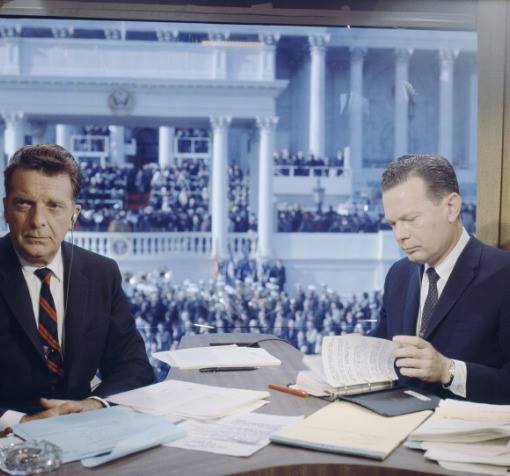
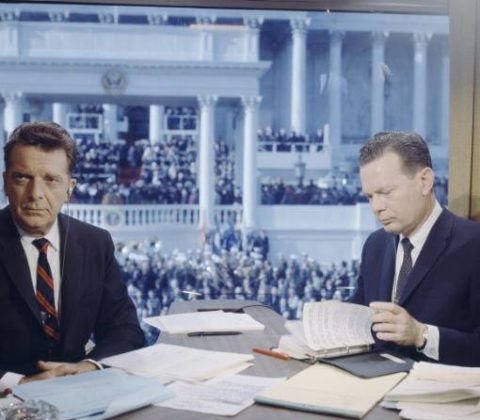
Television & The Presidential Inaugurations…Part 3 of 3
Television & The Presidential Inaugurations…Part 3 of 3
In photos 1,2 and 3, we see images from the inauguration of President Johnson and VP Hubert Humphrey in January 1965. For NBC the anchors were Chet Huntley and David Brinkley, with help from Hugh Downs and Barbara Walters. Peter Jennings was there for ABC with Marlene Sanders.
As they did in for the Kennedy inauguration, NBC color cast the parade, but not the capitol ceremonies. As we find out in this very good article on the LBJ television coverage, CBS was testing a new long lens with gyroscopic stability features which worked very well. NBC won the ratings battle by starting at 7 AM with “Today” hosts Downs and Walters, and ending coverage at 5:20, which was longer than ABC or CBS. This was the first time Telstar was used for the event and CBS videotape was broadcast to Europe on the new bird.
http://www.americanradiohistory.com/Archive-IBEW/IBEW-1965-02.pdf
Pictures 4 and 5 are from Nixon’s first inauguration in January 1969, which was the first time all three networks broadcast the whole thing in color. Seen here are Nixon and wife Pat at the White House preparing to leave for the capitol with a Norelco camera behind them. In the color photo, Hugh Downs and Barbara Walters are handling the early day coverage for NBC’s “Toady”.
In image 6, Gerald Ford is sworn in August 9, 1974 in the East Room of The White House. Nixon’s resignation was tendered at 11:35 AM, and Ford sworn in at 12:05 PM. Although there were not grand capitol steps ceremonies, parades or balls, I felt President Ford deserved a place here.
Pictures 7 and 8 are from the Jimmy Carter inauguration in 1977 and show one of NBC’s mobile unit Norelcos in action with John Chancellor and David Brinkley in the booth.
On the eve of the inauguration, the Carter family attended a Kennedy Center concert where Shirley Maclaine, Leonard Bernstein, James Dickey, John Wayne, Aretha Franklin and John Lennon contributed to the festivities.
On the gleaming inaugural platform the temperature was below freezing as the formal events commenced, but an audience of 150,000 braved the chill and gathered on the lawn of the Capitol, including my mother and dad, who were there as guests of the Carters.
Perhaps the highlight of the day came when the presidential limousine stopped at Constitution Avenue, where the new President and his wife stepped out and began to walk at the head of the inaugural parade down Pennsylvania Avenue, following the example of Thomas Jefferson.
The final three shots are from Reagan’s first inauguration in 1981. With Walter Cronkite is Bill Moyers and a CBS Thomson camera in image 9. In image 10, that is NBC’s John Chancellor and Roger Mudd at the capitol. At the Washington “Today” set, host Tom Brokaw stays in the studio to watch the coverage, including the announcement that the US Embassy hostages in Iran were on a plane bound for Germany. President Carter, who had been working 24 hours a day for his last two days in office, left the next day to meet them in Weisbaden Germany.
I wish there were more and better behind the scenes shots to show you, but it seems that the more inaugurations were covered – the mystic of how it was all done wore off. From here on, most of the available photos are quite boring, so with this, we bring this three part series to an end with the hopes you enjoyed this look back in time. -Bobby Ellerbee
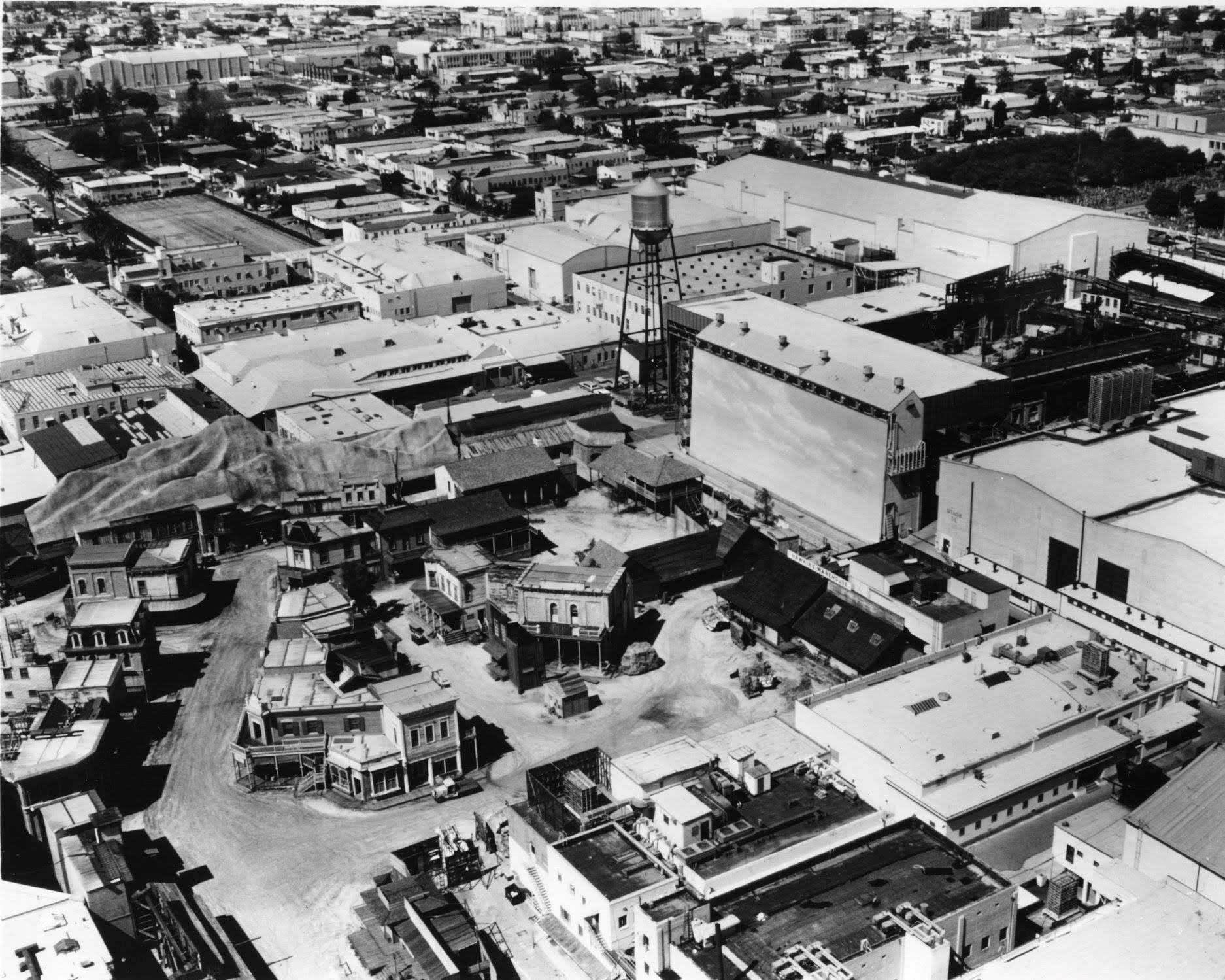
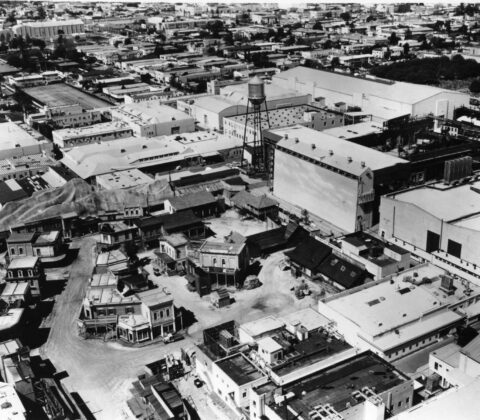
January 16, 1973…”Bonanza” & The Fake Mountain Come To An End
January 16, 1973…”Bonanza” & The Fake Mountain Come To An End
First, the “Bonanza” part of the story:
From September 12, 1959, until January 16, 1973 the men from The Ponderosa rode into our homes every week, but is wasn’t always a sooth ride. Initially the show aired opposite CBS blockbuster “Perry Mason” and the ratings were so bad that NBC wanted to kill the show, but RCA had a different idea.
“Bonanza” was one of the first series to be filmed in color and looked great on RCA’s big color sets, so they took over as the primary sponsor.
By 1961, ‘Bonanza’ was the number two show and stayed in the top three till 1970 and was number one from ’64 till ’67. By 1970, Bonanza was the first series to appear in the Top Five list for nine consecutive seasons (a record that would stand for many years) and thus established itself as the single biggest hit television series of the 1960s. Bonanza remained high on the Nielsen ratings until 1971, when it finally fell out of the Top Ten.
Now, about that “mountain” behind Virginia City…
The “mountain” at the rear of the Paramount Studios Western Street was actually constructed of a chicken-wire framework covered over by plaster and was immobile. I have highlighted in yellow where I think it was.
In March of 1959, ‘Bonanza’ producer David Dortort selected Paramount Studios in Hollywood to film the series. They had the largest sound stages and a good western street which was built for ‘Whispering Smith’ in 1947 starring Alan Ladd.
The reason the fake mountain was erected was to hide a high peaked construction mill built by Desilu in 1957. Another painted backdrop was located near the Western Street, for other shots, of a blue sky, with clouds. In the large annotated photo from 1975, you can see the “sky” behind the water set…the same one used in the parting of the waters in “The Ten Commandments”.
The Western Street was much smaller than the impressions we got from seeing it on “Bonanza” as wide-angle camera lenses made it appear much larger than in real-life. The local pigeons would frequently land and perch atop the fake mountain, shattering the illusion of distance and filming would be stopped until one of the crew members scared them away.
Other TV series made at the Western Street for exterior filming while “Bonanza” was being made there were “Have Gun-Will Travel”, “Branded”, and “The Guns of Will Sonnet”.
In 1979, a demolition team demolished the Western Street for an executive parking lot. The only building that was saved was the barn which was first seen in Cecil B. DeMille’s “The Squaw Man” the first feature film ever made in 1914. On the “Bonanza” series it is infrequently seen as the freight station. Enjoy and share! -Bobby Ellerbee
By the way, the last photo here shows Jerry Lewis filming “The Errand Boy” on this set.
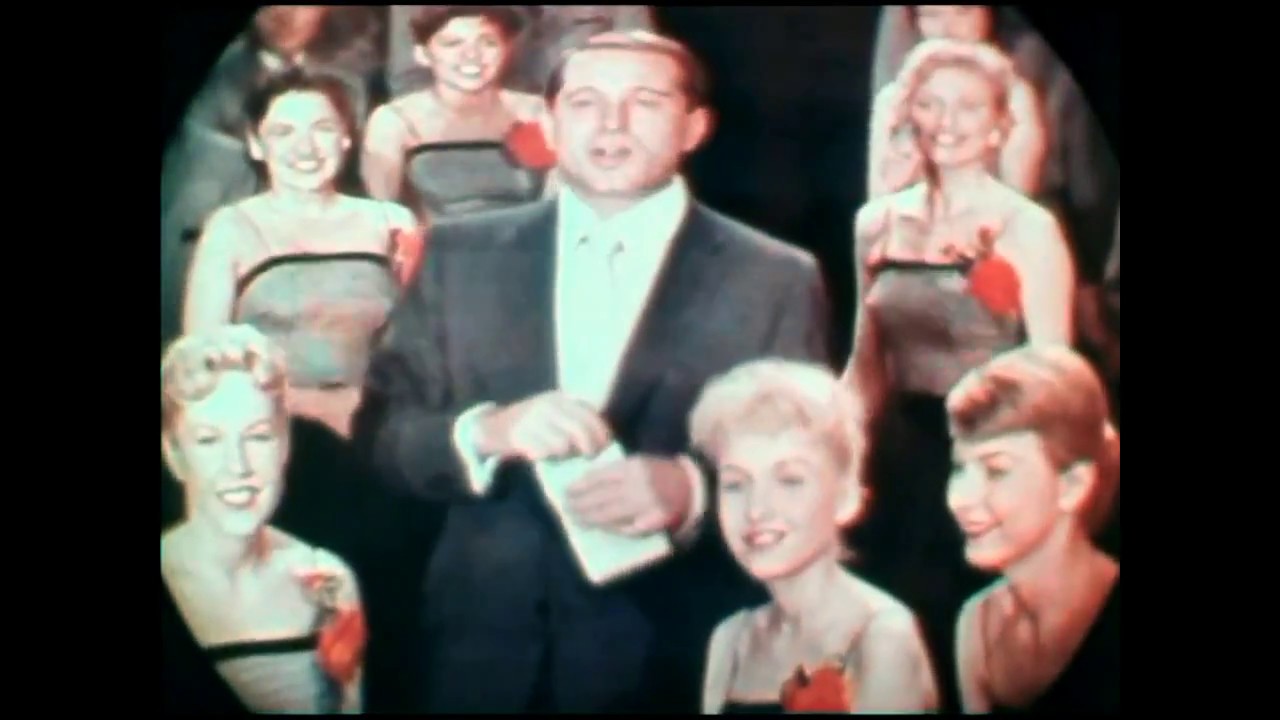
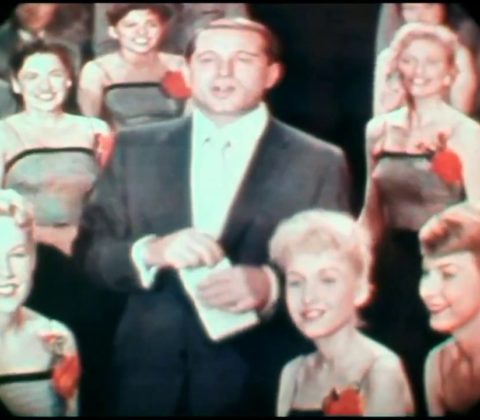
NBC Color Kinescopes Continued…Surprises & Rare Footage
NBC Color Kinescopes Continued…Surprises & Rare Footage
Yesterday, we discussed the RCA/Eastman Lenticular Color Kinescope process here, and from that we have gained more insight as well as two interesting new color kinescopes.
First, a few surprises. Surprise 1. It seems that one reason there are so few early kinescopes left is because the unions objected to more than one showing of the programs and demanded they be destroyed. The primary opposing force was the Musician’s Union, but others joined in too, claiming that, in an era when there was no such thing as residual payments, it was an unfair financial situation.
Surprise 2. NBC, the major innovator in kinescope use did not object to this…much. Yes, it was an expensive process for them to create and distribute the kines to affiliates not able to get live feeds yet, BUT…by it kept new live programming in demand. Dependency on them for content was important to the bottom line. It also kept the stations without live linkage from turning to outside film sources or local programming.
Surprise 3. It is not a surprise to say that color television was a lot more expensive than black and white, but the lengths to which RCA/NBC went to entice advertisers into becoming color sponsors was. Which helps explain the color kinescopes we are seeing here today.
These two color kinescopes we will see today, were more than likely created as pitch tools for the NBC ad sales department. The same is probably true of the Kovacs color kine we saw yesterday.
To be clear, Kovacs, the Perry Como and Arthur Murray color kinescopes were shot with regular 16mm Eastman color film and not on the lenticular Eastman film. The lenticular color process was used solely for the purpose of time shifting…so that Burbank could record live color feeds from NY, and develop the film in a 3 hour window to air in the west.
Since there was no urgency on the kinescopes made to show (via projector) at client meetings, they were done a different way, but they are indeed color kinescope recordings. Because of the difference in TV’s fields per second and film’s frames per second, only a kinescope camera could shoot this, as opposed to a regular motion picture camera.
Although the Kovacs, Como and Murray shows were live color broadcasts from NY, all three of these were most likely recorded at NBC Burbank on a modified kine machine there. All of these 3 videos fall within the time window that we believe the lenticular color kine system was in use at Burbank.
It is known that Burbank began experimenting with the RCA TRT-1 color video tape machine April 27, 1958 and that the new color capable Ampex VR1000 debuted at the April ’58 NAB convention, which Burbank had shortly after.
What we do not know, and never can know is this…are these recordings shot from the live feed from NY, or are these recordings of the lenticular playbacks on the west coast?
If they are the playbacks, they are not too shabby. If they are images of the live feed, still not too shabby and remind us how great the RCA TK41 was. What do you think?
Enjoy and share! -Bobby Ellerbee
https://www.youtube.com/watch?v=DBZgR8DHwM0 Perry Como
https://www.youtube.com/watch?v=TGoEXINk76Y Murray/Cooke
https://www.youtube.com/watch?v=lEBg6ansaJA Ernie Kovacs
Thanks to Troy Walters in Australia for the Como, Murray clips!
This is an ultra rare colour kinescope recording of the Perry Como Show which aired in living colour on NBC on 12th April 1958. Colour kinescope film recordi…
